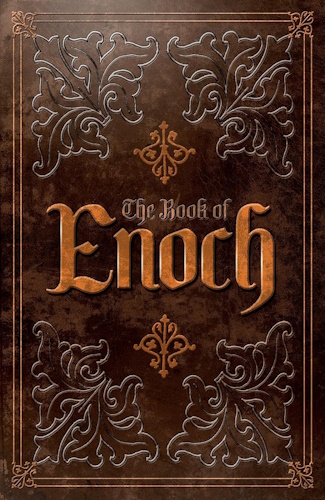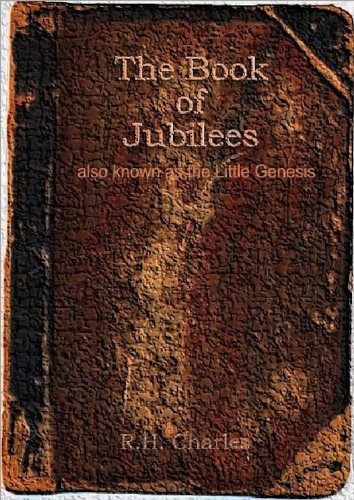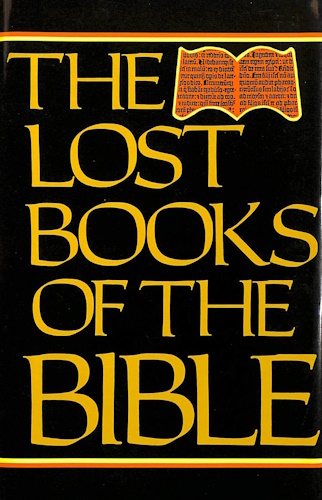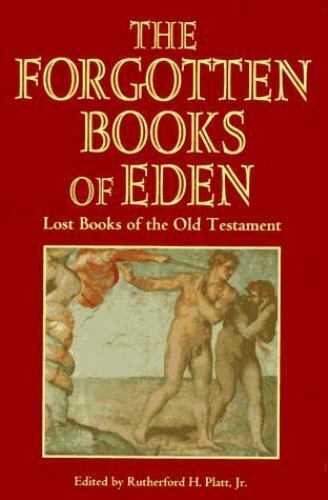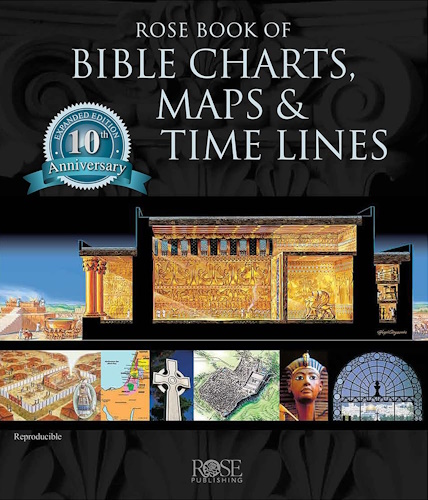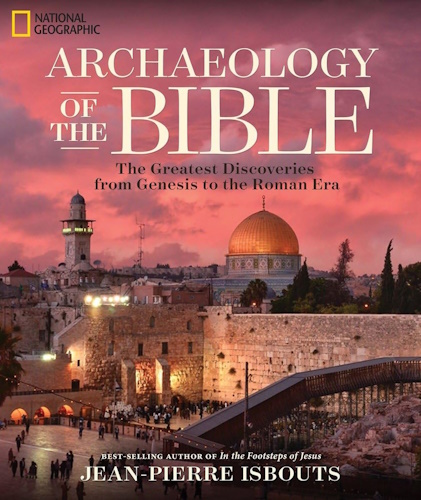
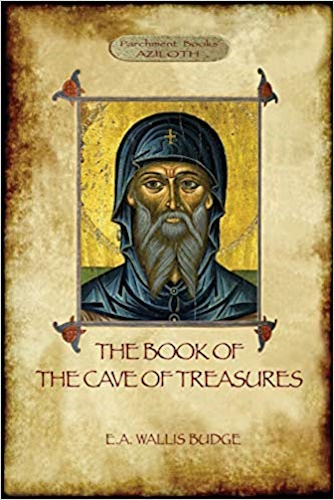
The Book Of The Cave Of Treasures
A History Of The Patriarchs And The Kings
Their Successors From The Creation
To The Crucifixion Of Christ
by
Sir E.A. Wallis Budge, KT.
M.A., LITT.D. (CAMBRIDGE), M.A., D.LITT. (OXFORD),
D.LIT. (DURHAM), F.S.A.
![]()
![]()
p. 111
[THE THIRD THOUSAND YEARS: FROM THE FLOOD TO THE REIGN OF REU.]
[Noah's entry into the Ark.]
The entrance of Noah into the Ark took place on the day of the eve of the Sabbath (Friday), on the seventeenth day of the blessed month of Îyâr (May). On the Friday, in the morning (i.e. the third hour) the beasts and the cattle went into the lowermost storey; and at midday all the feathered fowl and all the reptiles went into the middle storey; and at sunset Noah and his sons went into the Ark, on the east side of [the third storey], and his wife and the wives of his sons went to the west side. And the body of Adam was deposited in the middle of the Ark, wherein also all the mysteries of the Church were deposited. Thus women in church shall be on the west [side] [Fol. 17a, col. 2], and men on the east [side], so that the men may not see the faces of the women, and the women may not see the faces of the men. Thus also was it in the Ark; the women were on the west [side], and the men on the east [side], and the body of our father
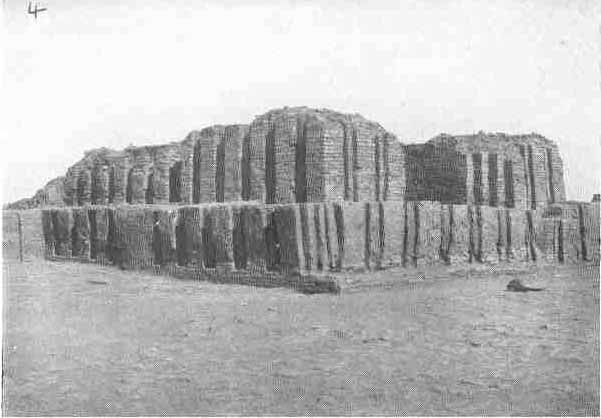
p. 112
Adam was placed between [them] like a raised stand (or throne). And as quietness reigneth in the Church between men and women, so also peace reigned in the Ark between the wild beasts, and the feathered fowl, and the creeping things (or reptiles). And as kings, and judges, and rich men, and poor men, and governors, and sick men, and beggars, live in concord, that is to say, in a general bond of peace, so also was it in the Ark. For lions, and panthers, and savage beasts of prey lived in peace and harmony with the cattle; and the beasts that were fierce and strong lived in peace with those that were timid and weak; and the lion with the ox, and the wolf with the lamb, and the lion's whelp [Fol. 17b, col. 1] with the calf, and the serpent with the dove, and the hawk with the sparrow.
[The Flood.]
And when Noah and his sons had gone into the Ark, and his wife and the wives of his sons, on the seventeenth day of the month of Îyâr (May), at sunset, the door of the Ark was shut fast, and Noah and his sons in captivity in the darkness. And as soon as the door of the Ark was shut, the floodgates of the heavens were opened, and the foundations of the earth were rent asunder, and Ocean, that great sea which surroundeth the whole world, poured forth its floods. And whilst
p. 113
the floodgates of heaven were open, and the foundations of the earth were rent asunder, the storehouses of the winds burst their bolts, and storm and whirlwinds swept forth, and Ocean roared and hurled its floods upon the earth. And the children of Seth, who had besmirched themselves in the mire of fornication, ran to the door of the Ark, and entreated Noah to open to them the door of the Ark. And when they saw the water floods which were swirling about them and engulfing [Fol. 17b, col. 2] them on all sides, they were in great tribulation, and they tried to climb up the mountains of Paradise, but were unable to do so. Now the Ark was closed and sealed, and the Angel of the Lord stood over one side of it that he might act as the pilot thereof. And when the floods of waters mastered the children of Seth, and they began to drown in their great and mighty waves--then was fulfilled that which David spake concerning them, saying, "I said, Ye are gods, and all of you sons of the Most High. (Ps. lxxxii. 6.) But since ye have done this, and ye have loved the fornication of the daughters of Cain, like them ye shall perish, and even as they did so shall ye die."
And when the Ark was lifted up from the earth by the mighty strength of the waters, all the children of men, and the wild beasts, and the feathered fowl, and the cattle, and the creeping
p. 114
things, and everything [living] on the face of the earth was drowned. And the waters [Fol. 18a, col. 1] of the Flood mounted up above all the tops of the high mountains fifteen cubits [variants, 25, 50 cubits], according to the measure of the Spirit. [The cubit of the Holy Ghost = 3 ordinary cubits.] And the flood waxed strong, and the waters thereof lifted up the Ark until it reached the skirts [of the mountain] of Paradise. And as the flood had been blessed by Paradise (i.e. had been made holy), it bowed its head, and kissed the skirts of Paradise and turned itself back to destroy the whole earth. And the Ark flew on the wings of the wind over the waters of the flood from east to west, and from north to south, and it marked out [by its path] a cross on the waters. And the Ark flew about for one hundred and fifty days, and it came to rest on the mountains of Kardô (i.e. Ararat, the Jabal al-Jûdî of the Arabs, near Jazîrat ibn `Umar) in the seventh month, that is to say, in the First Teshrî (October) on the seventeenth day thereof. And God commanded the waters, and they became separated from each other. The celestial waters were taken up, and ascended to their own place above [Fol. 18a, col. 2] the heavens, whence they came. The waters which had risen up from the earth returned to the lowermost abyss [under the earth]; and those which belonged to
p. 115
the Ocean [which surroundeth the whole world] returned to the innermost parts thereof. And the waters which had been on the earth, and had been assigned to it by the Divine Nod for the needs thereof from the beginning, remained upon it.
And the waters diminished little by little until the tenth month, which is Shebât (February), and on the first day thereof the tops of the mountains appeared. And, forty days later, on the tenth day of the month of Âdhâr (March), Noah opened the east window of the Ark, and sent forth a raven to bring back tidings; and the raven departed and did not return. And after the waters had diminished a little more from the earth, Noah sent forth a dove; and it found no place to rest, and it returned to Noah to the Ark. And after seven days he sent forth another dove, and it returned to him, carrying in its beak an olive leaf. Now the dove figureth for us the Two Covenants. In the First Covenant [Fol. 18b, col. 1] the spirit which spake by the Prophets did not find a place of rest among that rebellious people (i.e. the Jews); and in the Second Covenant it rested on the peoples through the waters of baptism.
[NOTES.--The above description of the Flood agrees substantially with that given in the Book of Adam (chapters ix and x), and in the Book of the Bee ( chapter xx).]
p. 116
[Noah leaves the Ark.]
And in the six hundred and first year of the life of Noah, on the first day of the month of Nîsân (April) the waters had dried up from the face of the earth. And in the second month, which is Îyâr (May), wherein Noah went into the Ark on the twenty-seventh day, on the holy first day of the week (Sunday), their going forth took place; and he and his wife went forth, and his sons and their wives went with them. Now, when they went into the Ark they went in in separate companies, Noah and his sons [in one company], and his wife and their wives in another company; and the men did not know the women until they went forth from the Ark. And all the wild beasts, and all the cattle, and all the feathered fowl, and all the creeping things went forth from the Ark on the first day of the week.
[Noah founds Themânôn, the city of the "Eight."]
And when they had gone forth Noah began work on the ground [Fol. 18b, col. 2], and they built a city and called the name thereof "Themânôn" (i.e. "Eight"), after the name of the eight souls who had gone forth from the Ark. And Noah built an altar, and offered up upon it an offering of beasts that were clean and feathered
p. 117
fowl. And God was appeased by the offering of Noah, and he established with him an everlasting covenant, and swore an oath, saying, "I will never again make a Flood." He took away the arrow of wrath from the bow which is in the clouds, and he stripped from it the string of anger, and spread it out (i.e. unbent it) in the clouds. For formerly, when the bow was bent in the firmament against that generation of the children of Cain, the murderer, they used to see the arrow of wrath placed in position on the string of anger, but after the Flood they did not see the arrow on the string.
[NOTE.--According to the Book of Adam (iii. 11), the waters dried up in the 607th year of the life of Noah. The altar on which Noah sacrificed was that on which Adam, Cain, and Abel had laid their offerings; it had been damaged by the Flood, but Noah rebuilt it. The city of Themânôn is îdentified with Sûbhâ (i.e. Nisîbis) in the Book of the Bee ( chapter xx), but this is a false identification. The "City of Eight," Themânôn, is not to be identified with the τὸ Θομάνων {Greek: tò Ðománwn} of Theophylact Simocatta (vol. ii. chap. 10, p. 86), which lay on the right bank of the Tigris near Hisn Kêfâ, but with the Sûk Thamânîn of the Arab geographers, which lay at a distance of one day's journey
p. 118
from Jazîrat ibn `Umar. It was situated high up in the mountains, and Khusraw Anôsharwân used to encamp there during the heats of summer. Near Burzmihrân, and between Jazîrat ibn `Umar and Thamânôn was Dêr Abbûn, which, according to Yâkût, contained the tomb of Noah. It is interesting to note that the Arabs call Noah's city Sûk Thamânîn (i.e. "Market of the Eighty") and not "Market of the Eight." For further details see Hoffmann, G., Auszüge aus syrischen Akten, page 174.]
[The Vineyard of Noah.]
And when they had gone forth from the Ark, they sowed seed and planted a vineyard; and they pressed out new wine. And Noah drew nigh, and drank some of it, and immediately he had drunk of it [Fol. 19a, col. 1] he became drunk. And having fallen asleep, his shame was seen, and his son Ham saw the nakedness of his father, and did not cover it; but he laughed at him and made a mock of him, and he ran and called his brethren that they also might make a mock of their father. And when Shem and Japhet heard of it they were dismayed exceedingly. And they rose up, and took a cloak, and walked backwards with their faces turned away that they might not see the nakedness of their father. And they cast the cloak over him and
p. 119
covered him. And when Noah woke up from the sleep of his wine, his wife told him about everything that had happened, and he also within himself knew what had happened to him. And Noah was exceedingly angry with his son Ham, and he said, "Cursed be Canaan; he shall be a servant of servants to his brethren."
Why, since the whole of the folly was Ham's, was Canaan cursed, except that, when the youth grew up [Fol. 19a, col. 2], and attained the full measure of his understanding, Satan entered into him, and became to him a teacher of sin? And he renewed the work of the house of Cain, the murderer. He constructed and made reed instruments and harps, and the fiends and the devils went unto them and dwelt therein. And immediately wind was blown through them (the reeds), the devils sang inside them, and sent forth loud sounds; and when men struck the harps the devils became operative inside them. And when Noah heard that Canaan had done this, he was grieved sorely, because the work of error, through which the fall of the children of Seth had taken place, was renewed. For by means of singing, and lewd play, and the mad lasciviousness of the children of Cain, Satan had cast down the mighty men, the "sons of God," into fornication. And through the music
p. 120
of reed pipes and harps sin had multiplied [Fol. 19b, col. 1] among the former generations until, at length, God became wroth and made the Flood. And Canaan was cursed because he had dared to do this, and his seed became a servant of servants, that is to say, to the Egyptians, and the Cushites, and the Mûsâyê (Mysians), [and the Indians, and all the Ethiopians, whose skins are black]. And because Ham had dared to make a mock of his father he was called "vile" (or "lascivious") all the days of his life.
Now Noah in his lying down in sleep, having drunk wine, symbolizeth the Cross of Christ, as the blessed man David singeth in his Psalm concerning him, saying, "Wake up, Lord, like a sleeping man, and like a man whom wine hath overcome." [Compare Psalm xlv. 23 {sic, Psalm xliv. 23}; lxxviii. 65.] Let the heretics who say "God was crucified" hold their peace. Here David calleth him "Lord," even as Peter the Apostle said, "This Jesus, whom ye crucified, hath God made Lord and Messiah (Christ)." (Compare Acts v. 30, 31.] He did not say "God" (Allâhâ), but "Lord" (Mâryâ), thus [Fol. 19b, col. 2] making known concerning the unity (or oneness) of the Two Persons who were united in one sonship. Now when Noah woke up from his sleep he cursed Canaan, and reduced his seed to slavery, and scattered his seed among the
p. 121
nations. And when our Lord rose from the dead He cursed the Jews, and scattered them among the nations. Now the seed of Canaan, as I have already said, are the Egyptians, and behold, they are scattered over the whole earth, and have been made servants of servants. And of what kind is this slavery of slavery? Behold, the Egyptians go round about all over the earth carrying loads on their backs (literally, necks). Now, men who are not fettered under the yoke of slavery, when despatched by their masters on journeys, do not march on their feet and carry loads, but they ride upon beasts in an honourable manner, like their masters. The seed of Ham are the Egyptians who carry loads, and they march [Fol. 20a, col. 1] on the roads with their backs and necks breaking under their loads, and they wander round to the doors of the children of their brethren. The seed of Ham was reduced, through the folly of Canaan, to suffer this penalty, that is, to become servants even to servants.
[NOTE.--The Book of the Bee ( chapter xx) says concerning the cursing of Ham, "The reason why he (Noah) cursed Canaan, who was not as yet born, nor had sinned, was because Ham had been saved with him in the Ark from the waters of the Flood, and had with his father received
p. 122
the divine blessing, and also because the arts of sin--I mean music and dancing and all other hateful things--were about to be revived by his posterity, for the art of music proceeded from the seed of Canaan." The same work adds, "After the Flood a son was born to Noah, and he called his name Yônatôn; and he provided him with gifts and sent him to the fire of the sun, to the east." The Book of Adam (iii. 13), merely states that Noah married another wife, who bore him seven children, and that he continued to dwell on that mountain until the end of his days.]
[The Death of Noah.]
And Noah lived three hundred and fifty years after he came forth from the Ark. And when he was sick unto death, Shem, and Ham, and Japhet, and Arpakhshar (Arphaxad), and Shâlah (Salah) gathered together unto him. And Noah called Shem, his firstborn, and said unto him privily, "Take heed, my son Shem, unto what I say unto thee this day. When I am dead, go into the Ark, wherein thou hast been saved, and bring out the body of our father Adam, and let no man have knowledge of what thou doest. And take with thee from this place provision for the way, bread and wine, and take with thee Melchisedek, the son of Mâlâkh [Fol. 20a, col. 2], because him hath God chosen from
p. 123
among all your descendants that he may minister before Him in respect of the body of our father Adam. And take the body and place it in the centre of the earth, and make Melchisedek to sit down there. And the Angel of God shall go before you, and shall show you the way wherein ye shall go, and also the place wherein the body of Adam shall be deposited, which is, indeed, the centre of the earth. There the four quarters of the earth embrace each other. For when God made the earth His power went before it, and the earth, from [its] four quarters, ran after it, like the winds and the swift breezes, and there (i.e. in the centre of the earth) His power stood still and was motionless. There shall redemption be made for Adam, and for all his posterity. Now this story, or mystery, was handed down to us from Adam in all generations [Fol. 20b, col. 1]. Adam commanded Seth, and Seth commanded Ânôsh (Enos), and Ânôsh commanded Kainân (Cainan), and Kainân commanded Mahlâlâîl, and Mahlâlâîl commanded Yârêd, and Yârêd commanded Enoch, and Enoch commanded Methuselah, and Methuselah commanded Lamech; and behold, I command thee this day. And take heed that this story is never mentioned again in all your generations. Get thee up, and take the body of Adam, and deposit it secretly in the place which God shall show thee
p. 124
until the day of redemption." And when Noah had given all these commands unto his son Shem, he died, [being] nine hundred and fifty years old, in the month of Îyâr (May), on the second day thereof, at the second hour of the first day of the week (Sunday). And Shem his son embalmed him, and buried him in the city which he had built (i.e. Themânôn), and they made a mourning for him forty days.
[NOTES.--According to the Book of the Bee, Noah died on the fourth day of the week (Wednesday), on the second day of the month of Nîsân (April), at the second hour of the day. The Book of Adam says that he was buried on the mountain on which the Ark rested. The same authority states (iii. chapter xiv) that the Ark was closed during the days of Noah, but that Noah went into it every evening to light the lamp which he had made, and which burned before the body of Adam. It is also stated that during his dying speech Noah indicated to each of his sons which part of the earth he was to dwell with his posterity. The territory of Shem extended from Jerusalem eastwards as far as India, and southwards as far as the mountains which divided Egypt from the land of the Philistines. It included Mount Zion, Mount Sinai, and the Garden of Eden. Ham's territory extended from
p. 125
Aris towards the south, as far as Fardundan and Gadariun, and also to the borders of the west. Japhet's portion was very large, and extended from the angle of the west to Damatha in the south, and all the north as far as Aris. Canaan, a descendant of Ham, had seven sons, and he seized seven of the great cities of Shem, and set these sons over them; and he doubled the size of his own portion. Later, God gave these cities back to the children of Shem, and blotted out Canaan's posterity, Kebra Nagast (chapter xii).]
[The Departure of Shem with the body of Adam.]
And after the death of Noah Shem did as his father had commanded him. And he went into [Fol. 20b, col. 2] the Ark by night, and brought out the body of Adam therefrom, and he sealed the Ark with his father's seal, and no man perceived [what he had done]. And he called Ham and Japhet, and said unto them, "My brethren, my father commanded me to go up and travel over the earth, even to the sea (i.e. the Mediterranean), and I am to see what the rivers are like, and then return unto you. And behold, my wife and the children of my house are with you (i.e. in your care); let your eyes be upon them." And his brethren said unto him, "Take with thee a company of men from the camp, for the
p. 126
land is a desert waste, and is shorn of inhabitants, and there are wild beasts therein." And Shem said unto them, "The Angel of the Lord shall go up with me, and he shall save me from every evil thing"; and his brethren said unto him, "Go in peace, and may the Lord God of our Fathers be with thee." And Shem said unto Mâlâkh (the brother of Shâlâh (Salah), the son of [Cainan] and [grand]son of Arphaxad), the father of Melchisedek, and Yôzadhâk, his mother, "Give ye me Melchisedek [Fol. 21a, col. 1], that he may go up with me, and be a consolation for me on the road." And Mâlâkh and Yôzadhâk, his mother, said unto Shem, "Take [him] and go in peace." And Shem gave commands unto his brethren, and said unto them, "My brethren, my father made me swear that neither I, nor any of your descendants, should go into the Ark," and he sealed the Ark with his seal, and said unto them, "Let no man go near it."
[Shem carries the body of Adam to Golgotha.]
And Shem took the body of Adam and Melchisedek, and went forth by night from among his people, and behold, the Angel of the Lord, who was going before them, appeared unto them. And their journey was very speedy, because the Angel of the Lord strengthened them until they arrived at that place. And when they arrived
p. 127
at Gâghûltâ (Golgotha), which is the centre of the earth, the Angel of the Lord showed Shem the place [for the body of Adam]. And when Shem had deposited the body of our father Adam upon that place [Fol. 21a, col. 2], the four quarters [of the earth] separated themselves from each other, and the earth opened itself in the form of a cross, and Shem and Melchisedek deposited the body of Adam there (i.e. in the cavity). And as soon as they had laid it therein, the four quarters [of the earth] drew quickly together, and enclosed the body of our father Adam, and the door of the created world was shut fast. And that place was called "Karkaphtâ " (i.e."Skull"), because the head of all the children of men was deposited there. And it was called "Gâghûltâ," because it was round [like the head], and "Resîphtâ " (i.e. a trodden-down thing), because the head of the accursed serpent, that is to say, Satan, was crushed there, and "Gefîftâ " (Gabbatha), because all the nations were to be gathered together to it.
[NOTES.--The Book of the Bee devotes a chapter ( xxi) to Melchisedek, and says that neither the father nor mother of this Melchisedek were written down in the genealogies; not that he had no natural parents, but that they were not written down. The greater number of the
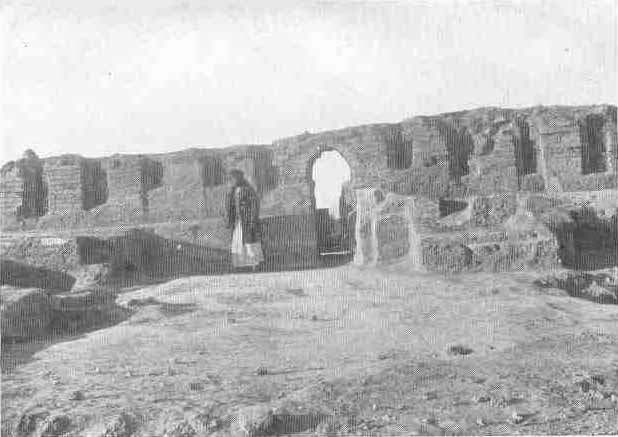
p. 128
doctors say that he was of the sect of Canaan, whom Noah cursed. In the Book of Chronography, however (the author), affirms and says that he was of the seed of Shem, the son of Noah. Shem begot Arphaxar, Arphaxar begot Cainan, and Cainan begot Shâlâh and Mâlâh. Shâlâh was written down in the genealogies; but Mâlâh was not, because his affairs were not sufficiently important to be written down in the genealogies. The Book of Adam (iii. 16) says that Cainan was the father of Melchisedek, and that the Angel of the Face, or Michael, appeared to him, and told him that he was going to send away his son from him. This same angel also appeared to Melchisedek and told him to go with Shem, and to minister before the body of Adam in the centre of the earth, and also to Shem. After his interview with the angel, Shem made a splendid coffin to hold the body of Adam, and prepared bread and wine for the journey. When he and Melchisedek went to the Ark to take out the body, they found that the door of it had been locked by Noah, and they had no key to open it. As soon as Melchisedek touched the lock the door opened of itself, and the voice of Adam was heard to address him as the "priest of the Most High God." Melchisedek went into the Ark, and Michael helped him to carry out Adam's body, and Shem brought out the gold,
p. 129
frankincense and myrrh. Shem laid the body in the coffin which he had made, and then shut the door of the Ark. Melchisedek was fifteen years of age when he set out with Shem. The voice of Adam told Shem when they arrived at the centre of the earth, and as soon as the coffin touched the rock, the rock split asunder to receive it. On the following morning Melchisedek builded an altar of twelve stones, and offered up upon it the bread and wine which Shem had brought from Paradise.]
[Shem's commands to Melchisedek.]
And Shem said unto Melchisedek, "Thou shalt be the priest of the Most High God, because thou alone hath God chosen to minister before Him in this place. And thou shalt sit (i.e. dwell) here continually, and shalt not depart from this place all the days of thy life. Thou shalt not take a wife, thou shalt not shave thy head, and thou shalt not pour out blood [Fol. 21b, col. 1] in this place. Thou shalt not offer up wild beasts nor feathered fowl, but thou shalt offer up bread and wine always; and thou shalt not build a building in this place. And behold, the Angel of the Lord shall come down to thee and visit thee continually." And Shem embraced and kissed Melchisedek, and blessed him, and he returned to his brethren. And Mâlâkh, the
p. 130
father of Melchisedek, and Yôzâdhâk, his mother, said [unto Shem], "Where is the young man?" And he said, "He died on the journey, and I buried him there" (i.e. where he died); and they mourned for him greatly.
[NOTES.--A scribe's note says that in the manuscript of one Makbal Melchisedek's father was called "Harklêîm" and his mother "Shêlâthîêl " (Budge, Book of the Bee, page 34). Melchisedek wore a tunic of skin and a leather girdle, and an angel dwelt with him, and protected him, and gave him food (Book of Adam, iii. 21). When he was old, the kings of the earth heard his fame, and eleven of them gathered together and came to see him; and they entreated him to go with them, but he would not be persuaded. And when he did not conform to their wishes, they built a city for him there, and he called it Jerusalem; and the kings said to one another, "This is the king of all the earth, and the father of nations."]
[The Generations of Shem.]
And when Shem had lived six hundred years he died, and Arphakhshar, his son, and Shâlâh (Salah), and `Abhâr (Eber), his sons, buried him.
And Arphakhshar was thirty and five years old when he begot Shâlâh, and all the days of his
p. 131
life were four hundred and thirty-eight years [Fol. 21b, col. 2], and he died, and Shâlâh, his son, and `Abhâr and Pâlâg (Peleg) buried him in Arpakhsharath, the city which he built after his own name.
[NOTE.--After Shem the Book of Adam (iii. 22) inserts the name of Cainan, the father of Melchisedek (sic), who lived 589 years. Shem's years are given as 550.]
Salah was thirty years old when he begot Eber, and all the days of his life were four hundred and thirty-three years [Ethiopic variant, 408 years], and he died, and Eber, his son, and Peleg, and Ar`ô (Reu) puried hill in Shelîhôn, the city which he built after his own name.
Eber was thirty and four years old when he begot Peleg; and all the days of his life were four hundred and sixty-four [Ethiopic variant, 434] years; and he died, and Peleg his son and Reu and Sorôgh (Serug) buried him in `Ebhrîn, the city which he built after his own name.
Peleg was thirty years old when he begot Reu; and all the days of his life were two hundred and thirty-nine years, and he died [and they buried him in the city of Peleg, which he had built after his own name].
p. 132
[The Migration to the land of Sêntar.]
And in the days of Peleg all the tribes and families of the children of Noah gathered together, and went up from the East. And they found a [Fol. 22a, col. 1] plain in the land of Sên`ar (Shinar ?), and they all sat down there; and from Adam until this time they were all of one speech and one language. They all spake this language, that is to say, SÛRYÂYÂ (Syrian), which is ÂRÂMÂYÂ(Aramean), and this language is the king of all languages. Now, ancient writers have erred in that they said that Hebrew was the first [language], and in this matter they have mingled an ignorant mistake with their writing. For all the languages there are in the world are derived from Syrian, and all the languages in books are mingled with it. In the writing of the Syrians the left hand stretcheth out to the right hand, and all the children of the left hand (i.e. the heathen) draw nigh to the right hand of God; now with the Greeks, and Romans, and the Hebrews, the right hand stretcheth out to the left. [Both Hebrew and Syriac are written from right to left, but Greek and Latin from left to right.]
[Fol. 22a, col. 2.] And in the days of Peleg the Tower which is in Babel was built, and there the tongues of men were confounded. [A marginal note says, "the division of tongues
p. 133
took place at midnight."] And from that place they were scattered over the face of all the earth; and that place was called "Babel," because tongues were confounded there.
[NOTE.--The name Babel or Babylon has nothing to do with the Hebrew words "to mix, to confound." "Babel" is a transcription of the Assyrian words "Bâb-ilu," which mean "Gate of God," and which are the Semitic translation of the Sumerian words KA-DINGIRRA-KI.]
And after the division of tongues Peleg died in great sorrow, and with tears in his eyes and grief in his heart, because in his days the earth was divided. And his son Reu, and Serug, and Nâhôr buried him in Peleghîn, the city which he had built after his own name. And there were seventy-two tongues in the earth, and seventy-two heads of tribes (or families), and each tribe and tongue made unto themselves a chief like a king.
[The Posterity of Japhet.]
And the seed of Japhet became thirty-seven nations and kingdoms; viz. Gâmâr (Gomer), and Yâwân, and Mâdhâi, and Tûbîl, and Mâshêkh [Fol. 22b, col. 1], and Tîrês, and all the kingdoms of the Alânâyê; all these are the children of Japhet.
p. 134
[NOTES.--Another list gives: Gomer (Goths), Magog (Galatians), Madai (Medes), Javan (Greeks), Tûbîl (Bithynians), Meshech (Mysians), Tîras (Thracians), and the Anshklâyê. From Gomer sprang the Ashkenaz (Armenians), Danphar (Cappadocians), Togarmah (Asians), and the Isaurians. From Javan sprang Halles (Hellas), Tarshish, Cilicia, Cyprus, Kittim, Doranim (see Gen. x. 4), and the Macedonians. Book of the Bee ( chapter xxii).]
And the sons of Hâm--Kûsh (Nubia), and Mesrîm (Egypt), and Pôt, and Canaan, and all their children. And the sons of Shem--`Îlâm (Elamites), and Âshôr (Assyrians), and Arpakhshar (Persians ?), and Lôdh (Lud), and Ârâm (Arameans, Damascenes, and Harranites), and all their children. Now the children of Japhet clung to the borders of the east, from the Mountain of Nôdh, which is on the confines of the east, to the Tigris and the confines of the north, and from Baktôrônôs (Bactria ?) as far as Gadhrîôn (Gadarea ?). And the children of Shem held from Persia [in] the east as far as the sea of Tadhrasnkôs in the west; unto them belongeth the middle of the earth, and they held sovereignty and dominion therein. The children of Shem occupy all the southern and a little of the western quarter.
p. 135
And Reu lived thirty-two years, and begot Serug. And in the days of Reu, in his one hundred [Fol. 22b, col. 2] and thirtieth year, Nimrod, the mighty man, the first king on the earth, reigned, and he reigned sixty-nine years; and the beginning of his kingdom was Babel. This Nimrod saw the figure of a crown in the heavens, and he called Sîsân, the weaver, who wore a crown like unto it, and he set it on his head. And because of this men used to say that the crown came down to him from heaven.
[NOTE.--Nimrod became so wicked that he thought he was God. Book of Adam (iii. 23).]
IN THE DAYS OF REU THE THIRD THOUSAND YEARS CAME TO AN END.
-
Urantia Book, 44:0.11 - The Celestial Artisans
Never in your long ascendancy will you lose the power to recognize your associates of former existences. Always, as you ascend inward in the scale of life, will you retain the ability to recognize and fraternize with the fellow beings of your previous and lower levels of experience. Each new translation or resurrection will add one more group of spirit beings to your vision range without in the least depriving you of the ability to recognize your friends and fellows of former estates.
-
Princess Bride 1987 Wallace Shawn (Vizzini) and Mandy Patinkin (Inigo Montoya)
Vizzini: HE DIDN'T FALL? INCONCEIVABLE.
Inigo Montoya: You keep using that word. I do not think it means what you think it means. -
Urantia Book, 117:4.14 - The Finite God
And here is mystery: The more closely man approaches God through love, the greater the reality -- actuality -- of that man. The more man withdraws from God, the more nearly he approaches nonreality -- cessation of existence. When man consecrates his will to the doing of the Father's will, when man gives God all that he has, then does God make that man more than he is.
-
Urantia Book, 167:7.4 - The Talk About Angels
"And do you not remember that I said to you once before that, if you had your spiritual eyes anointed, you would then see the heavens opened and behold the angels of God ascending and descending? It is by the ministry of the angels that one world may be kept in touch with other worlds, for have I not repeatedly told you that I have other sheep not of this fold?"
-
Urantia Book, Foreword - 0:12.12 - The Trinities
But we know that there dwells within the human mind a fragment of God, and that there sojourns with the human soul the Spirit of Truth; and we further know that these spirit forces conspire to enable material man to grasp the reality of spiritual values and to comprehend the philosophy of universe meanings. But even more certainly we know that these spirits of the Divine Presence are able to assist man in the spiritual appropriation of all truth contributory to the enhancement of the ever-progressing reality of personal religious experience—God-consciousness.
-
Urantia Book, 1:4.3 - The Mystery Of God
When you are through down here, when your course has been run in temporary form on earth, when your trial trip in the flesh is finished, when the dust that composes the mortal tabernacle "returns to the earth whence it came"; then, it is revealed, the indwelling "Spirit shall return to God who gave it." There sojourns within each moral being of this planet a fragment of God, a part and parcel of divinity. It is not yet yours by right of possession, but it is designedly intended to be one with you if you survive the mortal existence.
-
Urantia Book, 1:4.1 - The Mystery Of God
And the greatest of all the unfathomable mysteries of God is the phenomenon of the divine indwelling of mortal minds. The manner in which the Universal Father sojourns with the creatures of time is the most profound of all universe mysteries; the divine presence in the mind of man is the mystery of mysteries.
-
Urantia Book, 1:4.6 - The Mystery Of God
To every spirit being and to every mortal creature in every sphere and on every world of the universe of universes, the Universal Father reveals all of his gracious and divine self that can be discerned or comprehended by such spirit beings and by such mortal creatures. God is no respecter of persons, either spiritual or material. The divine presence which any child of the universe enjoys at any given moment is limited only by the capacity of such a creature to receive and to discern the spirit actualities of the supermaterial world.
-
Urantia Book, 11:0.1 - The Eternal Isle Of Paradise
Paradise is the eternal center of the universe of universes and the abiding place of the Universal Father, the Eternal Son, the Infinite Spirit, and their divine co-ordinates and associates. This central Isle is the most gigantic organized body of cosmic reality in all the master universe. Paradise is a material sphere as well as a spiritual abode. All of the intelligent creation of the Universal Father is domiciled on material abodes; hence must the absolute controlling center also be material, literal. And again it should be reiterated that spirit things and spiritual beings are real.
-
Urantia Book, 50:6.4 - Planetary Culture
Culture presupposes quality of mind; culture cannot be enhanced unless mind is elevated. Superior intellect will seek a noble culture and find some way to attain such a goal. Inferior minds will spurn the highest culture even when presented to them ready-made.
-
Urantia Book, 54:1.6 - True And False Liberty
True liberty is the associate of genuine self-respect; false liberty is the consort of self-admiration. True liberty is the fruit of self-control; false liberty, the assumption of self-assertion. Self-control leads to altruistic service; self-admiration tends towards the exploitation of others for the selfish aggrandizement of such a mistaken individual as is willing to sacrifice righteous attainment for the sake of possessing unjust power over his fellow beings.
-
Urantia Book, 54:1.9 - True And False Liberty
How dare the self-willed creature encroach upon the rights of his fellows in the name of personal liberty when the Supreme Rulers of the universe stand back in merciful respect for these prerogatives of will and potentials of personality! No being, in the exercise of his supposed personal liberty, has a right to deprive any other being of those privileges of existence conferred by the Creators and duly respected by all their loyal associates, subordinates, and subjects.
-
Urantia Book, 54:1.8 - True And False Liberty
There is no error greater than that species of self-deception which leads intelligent beings to crave the exercise of power over other beings for the purpose of depriving these persons of their natural liberties. The golden rule of human fairness cries out against all such fraud, unfairness, selfishness, and unrighteousness.





